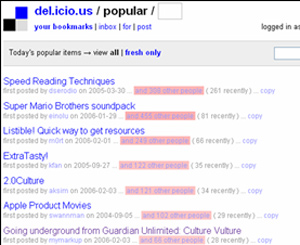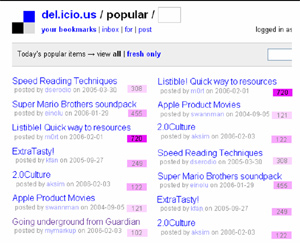Folksonomy by [[Thomas Vander Wal]] on 2007-02-02
- Jul 2025
-
vanderwal.net vanderwal.net
- Jun 2023
-
jakobib.github.io jakobib.github.io
-
link.springer.com link.springer.com
-
asistdl.onlinelibrary.wiley.com asistdl.onlinelibrary.wiley.com
-
searchengineland.com searchengineland.com
-
accidental-taxonomist.blogspot.com accidental-taxonomist.blogspot.com
- May 2023
- Jan 2023
-
www.slideshare.net www.slideshare.net
- Jun 2022
-
cyber.harvard.edu cyber.harvard.edu
-
TagTeam is an open-source tagging platform and feed aggregator developed for the Harvard Open Access Project (HOAP) at the Berkman Klein Center for Internet & Society under the direction of Peter Suber.
About TagTeam
Tags
Annotators
URL
-
-
Local file Local file
-
Dabei ist zu beachten, dass die Beiträge ver-schlagwortet werden können über die Option „Tags“. Dadurch werden die jewei-ligen Sendungen leichter auffindbar und mehr von den YouTube-Algorithmenberücksichtig
Folksonomy
-
-
zettelkasten.de zettelkasten.de
-
Simply stated, Luhmann’s Zettelkasten structure was not dynamic or fluid in nature. Yet, it was not rigid, either. Examples of a rigid structure are classification systems like the Dewey Decimal Classification System or Paul Otlet’s massive notecard world museum known as, The Mundaneum. These types of systems are helpful for interpersonal knowledge systems; however, they’re not illustrative of what Niklas Luhmann’s system was: an intrapersonal communication system. Luhmann’s notebox system was not logically and neatly organized to allow for the convenience of the public to access. Nor was it meant to be. It seemed chaotic to those who perused its contents other than its creator, Niklas Luhmann. One researcher who studied Luhmann’s system in person says, “at first glance, Luhmann’s organization of his collection appears to lack any clear order; it even seems chaotic. However, this was a deliberate choice.” (11)11 Luhmann’s Zettelkasten was not a structure that could be characterized as one of order. Indeed, it seems closer to that of chaos than order.
This seems illustrative of the idea that some of the most interesting things in life or living systems exist at the chaotic borders.
There seem to be differences between more rigid structures like the Dewey Decimal Classification system or Paul Otlet's Mundaneum and less rigid branching systems like Luhmann's version of his zettelkasten. Is this really a difference or only a seeming difference given the standardization some of the systems. There should be a way to do both. Maybe it's by the emergence of public standards, or perhaps it's simply through the use of subject headings and the cross linking of emerging folksonomies.
What does the use of platforms like the Federated Wiki or the early blogosphere and linking and discovery methods enabled by Technorati indicate?
Luhmann's system may seem intrapersonal, perhaps as a result of the numbering system, but it becomes highly penetrable by the subject index and the links from one idea (card) to the next. Use over time makes it even easier.
-
- May 2022
-
fr.slideshare.net fr.slideshare.net
-
ontologiemoat.wordpress.com ontologiemoat.wordpress.com
Tags
Annotators
URL
-
-
www.slideshare.net www.slideshare.net
Tags
Annotators
URL
-
- Apr 2022
-
scottberkun.com scottberkun.com
-
-
sondern sie suchen hier 00:17:52 nach wirklichen gehalten hat sie suchen hier wirklich im wirklichen text und sie suchen nicht nur nach texten die suche nach bildern sie suchen nach allem möglichen nachteilen sie können alle möglichen arten von informationen suchen
Der formale Zwischenschritt wird kleiner bzw. verschwindet. Ich suche nicht über die Form des Autors nach den Inhalten, sondern direkter nach Inhalten. So gestaltet sich auch die Folksonomie / das social tagging als inhaltsorientierter - es ist nicht mehr wie die Enzyklopädie alphabetisch geordnet.
-
- Mar 2022
-
Local file Local file
-
Research into combining algorithmic methods and human curation to find the best information as well as eliminating the worst is just get-ting started. Michael Noll, Ching-man Au Yeung, Nicholas Gibbins, Chris-toph Meinel, and Nigel Shadbolt presented a paper in 2009 titled “Telling Experts from Spammers: Expertise Ranking in Folksonomies.”111 Noll and his colleagues applied their algorithm to a data set of a half-million users of the social bookmarking service Delicious.com and claim to be able to auto-matically detect experts, in part by looking for the first people to bookmark a resource that ends up being bookmarked by many other users. A folk-sonomy is the classification scheme that emerges when large numbers of people apply their own categories (for example, tags) instead of fitting them into a predesigned categorization system (an ontology). Remember how the dictionary, the index, and classification systems developed in response to the print revolution’s info overload? It’s happening again.
Taxonomies by folks - Folksonomy - Analogie zur Entwicklung des Wörterbuchs - spannende Beobachtung und spannende These
-
- Jan 2022
-
fr.slideshare.net fr.slideshare.net
- Oct 2020
-
web.hypothes.is web.hypothes.is
-
It isn't rocket science, but as Jon indicates, it's incredibly powerful.
I use my personal website with several levels of taxonomy for tagging and categorizing a variety of things for later search and research.
Much like the example of the Public Radio International producer, I've created what I call a "faux-cast" because I tag everything I listen to online and save it to my website including the appropriate <audio> link to the.mp3 file so that anyone who wants to follow the feed of my listens can have a playlist of all the podcast and internet-related audio I'm listening to.
A visual version of my "listened to" tags can be found at https://boffosocko.com/kind/listen/ with the RSS feed at https://boffosocko.com/kind/listen/feed/
-
- Apr 2020
-
web.archive.org web.archive.org
-
Perhaps the best way to understand the weird things that people do with folksonomy tags is to appeal, not to information science, but to narratology, the study of narrative structures. Traditional narratology recognizes four basic forms of narrative structure: romance, in which we fight against the constraints of the universe and overcome those constraints; tragedy, in which we fight against the constraints of the universe and succumb to those constraints; comedy, in which we fight against the constraints of the universe and then find those constraints to be in harmony with our goals; and satire, which ridicules the notion that experience can be comprehended by an organizing structure of any kind.
Something about the broadness of these definitions really appeals to me.
-
- Aug 2019
-
web.hypothes.is web.hypothes.is
-
A sidebar annotating the web, like SideWiki should have been.
Social bookmarking, tagging, annotating and note sharing of the web in public or private groups, or just for yourself.
source and other projects at https://github.com/hypothesis - opensource (but alas, not copyleft)
-
-
oerfuture.net oerfuture.net
-
checkout how this teacher uses hypothes.is annotations in the classroom
-
- Oct 2018
-
www.kde.cs.uni-kassel.de www.kde.cs.uni-kassel.de
-
www.uni-kassel.de www.uni-kassel.demain.dvi1
- Jun 2018
-
en.wikipedia.org en.wikipedia.org
-
When users can freely choose tags (creating a folksonomy, as opposed to selecting terms from a controlled vocabulary), the resulting metadata can include homonyms (the same tags used with different meanings) and synonyms (multiple tags for the same concept), which may lead to inappropriate connections between items and inefficient searches for information about a subject.
-
Tagging systems open to the public are also open to tag spam, in which people apply an excessive number of tags or unrelated tags to an item (such as a YouTube video) in order to attract viewers. This abuse can be mitigated using human or statistical identification of spam items.[48] The number of tags allowed may also be limited to reduce spam.
-
The success of Flickr and the influence of Delicious popularized the concept,[21] and other social software websites—such as YouTube, Technorati, and Last.fm—also implemented tagging
-

